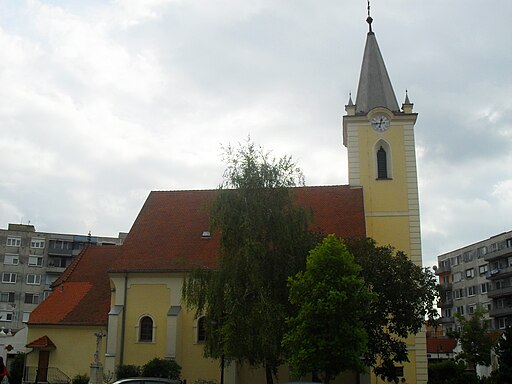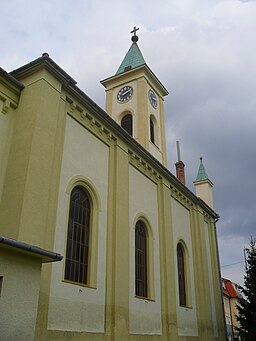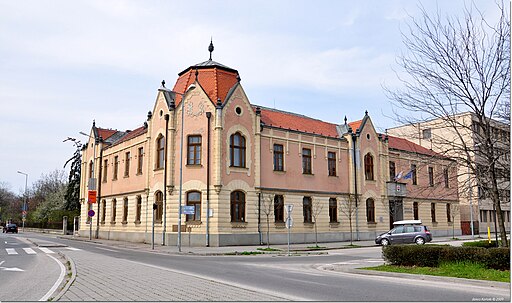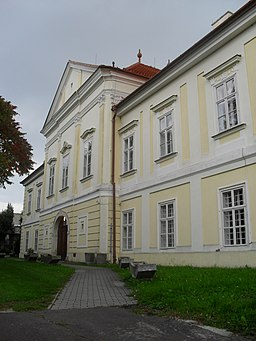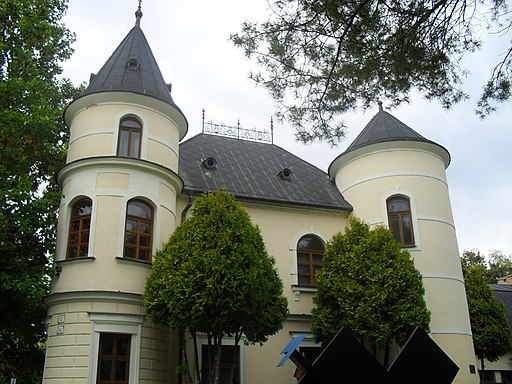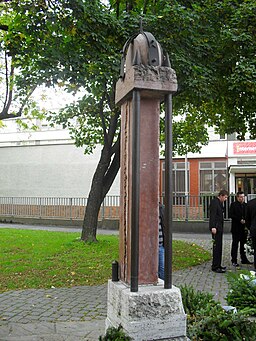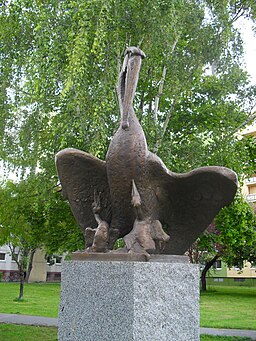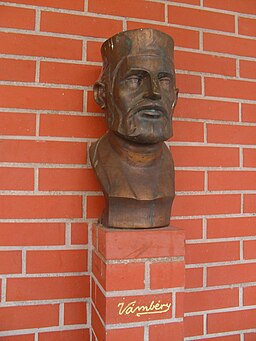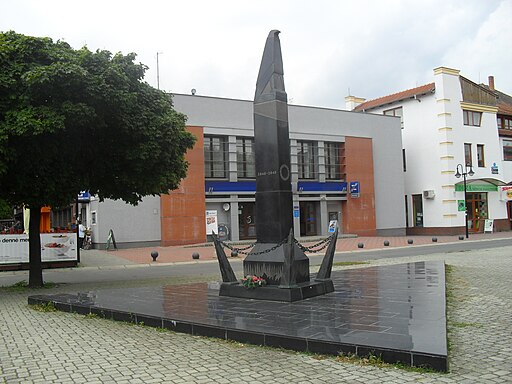Dunaszerdahely
Dunajská Streda
Dunaszerdahely
Historical Hungarian county:
Pozsony
River:
The town is on one of the islands on the Danube.
GPS coordinates:
47.993788, 17.617903
Population
Population in 1910
| Total |
4762 |
| Hungarian |
98.26% |
The town is the center of Csallóköz, which is the largest inland island of the Danube River and also the entire Europe. It is one of the most fertile lands of the country and it covers its largest underground water reservoir, which the visitors can enjoy as well in its thermal spas. The population of the area is still predominantly Hungarian, and the town is also one of the few towns of the former Upper Hungary whose Hungarian majority could still not be broken by the Czech-Slovak invaders. Sorrowfully a significant part the historic town center was destroyed by the Slovak nationalists operating under the cloak of communism, but was renewed in a unique image during the nineties according to the plans of the Hungarian architect Makovecz Imre.
Check out other towns in Upper Hungary (Slovakia) as well!
895
Arrival of the Hungarians
Little more...
895
The alliance of the seven Hungarian tribes took possession of the then largely uninhabited Carpathian Basin. Until then, the sparse Slavic population of the north-western Carpathians had lived under Moravian rule for a few decades after the collapse of the Avar Khaganate in the early 9th century.
1000
Foundation of the Hungarian Kingdom
Little more...
1000
The Kingdom of Hungary was established with the coronation of King Stephen I. He converted the Hungarians to Christianity and created two archdioceses (Esztergom and Kalocsa) and ten dioceses. He divided Hungary into counties led by ispáns, who were appointed by the king.
1241-1242
Mongol Invasion
Little more...
1241-1242
The hordes of the Mongol Empire invaded Hungary and almost completely destroyed it. One third to one half of the population was destroyed. The Mongols also suffered heavy losses in the battle of Muhi and they could not hunt down the king. After their withdrawal, King Béla IV reorganized Hungary. He allowed the feudal lords to build stone castles because they were able to successfully resist the nomadic Mongols. The vast majority of stone castles were built after this. The king called in German, Vlach (Romanian) and Slavic settlers to replace the destroyed population.
1256
The settlement was mentioned for the first time as "Svridahel".
1301
The extinction of the House of Árpád
Little more...
1301
The House of Árpád, the first Hungarian royal dynasty, died out with the death of King Andrew III. Hungary was ruled by oligarchs, the most powerful of whom was Csák Máté, whose main ally was the Aba family. King Charles I (1308-1342), supported by the Pope, eventually emerged as the most prominent of the contenders for the Hungarian throne. But it took decades to break the power of the oligarchs.
14th century
The town's core, the so called 'Szentfundus' was built. It is the area around the Catholic church, encircled by walls. The walls were demolished in the 19th century.
1429
It was mentioned as an oppidum (agricultural town) in an order issued by King Sigismund of Hungary.
1526
Battle of Mohács and the splitting of Hungary into two parts
Little more...
1526
Sultan Suleiman I launched a war against Vienna, instigated by the French. Ferdinand I, Duke of Austria, was the brother-in-law of King Louis II of Hungary. The army of the Ottoman Empire defeated the much smaller Hungarian army at Mohács, and King Louis II died in the battle. A group of the barons elected Ferdinand I of the House of Habsburg to the throne, who promised to defend Hungary from the Turks. He was the younger brother of the most powerful European monarch Emperor Charles V. But the nobility chose the most powerful Hungarian baron, Szapolyai János, who was also crowned as King John I. The country was split in two and a decades-long struggle for power began.
1541
The Turkish occupation of the capital, Buda, and the division of Hungary into three parts
Little more...
1541
The Turks conquered Buda, the capital of Hungary, after the death of King John I. The central part of the country was under Turkish rule for 150 years. The western and northern parts (including present-day Slovakia) formed the Kingdom of Hungary ruled by the Habsburg emperors. The eastern parts (now mainly under Romanian rule) were ruled by the successors of King John I of Hungary. In 1571, John II (John Sigismund), the son of King John I of Hungary, renounced the title of King of Hungary in favor of King Maximilian of the House of Habsburg, and henceforth held the title of Prince. This formally created the Principality of Transylvania, which was the eastern half of Hungary not ruled by the Habsburgs and was also a vassal of the Ottoman Empire. John II died in 1571, after which the three nations of Transylvania (the Hungarian nobility, the Székelys and the Saxons) elected the prince.
1599
The town became the property of the Pálffy family.
1686
Recapture of Buda and the liberation of Hungary from the Turks
Little more...
1686
The army of the Holy League recaptured Buda from the Turks by siege. In 1687, the Imperial army invaded the Principality of Transylvania. The liberation was hindered by the French breaking their promise of peace in 1688 and attacking the Habsburg Empire. By 1699, when the Peace of Karlóca was signed, all of Hungary and Croatia had been liberated from the Ottoman Empire with the exception of Temesköz, the area bounded by the Maros, the Tisza and the Danube rivers. It was not until the Peace of Požarevac in 1718 that Temesköz was liberated from the Turks. However, the continuous war against the Turkish invaders and the Habsburg autocracy, which lasted for more than 150 years, wiped out large areas of the Hungarian population, which had previously made up 80% of the country's population, and was replaced by Vlachs (Romanians), Serbs and other Slavic settlers and Germans. The Habsburgs also favoured the settlement of these foreign peoples over the 'rebellious' Hungarians.
1703-1711
Hungarian War of Independence led by Prince Rákóczi Ferenc II
Little more...
1703-1711
After the expulsion of the Turks, the Habsburgs treated Hungary as a newly conquered province and did not respect its constitution. The serfs rose up against the Habsburg ruler because of the sufferings caused by the war and the heavy burdens, and they invited Rákóczi Ferenc II to lead them. Trusting in the help promised by King Louis XIV of France, he accepted. Rákóczi rallied the nobility to his side, and soon most of the country was under his control. The rebels were called the kurucs. In 1704, the French and the Bavarians were defeated at the Battle of Blenheim, depriving the Hungarians of their international allies. The Rusyn, Slovak and Vlach peasants and the Saxons of Szepes supported the fight for freedom, while the Serbs in the south and the Saxons in Transylvania served the Habsburgs. Due to lack of funds Rákóczi could not raise a strong regular army, and in 1710, Hungary was also hit by a severe plague. Rákóczi tried unsuccessfully to forge an alliance with Tsar Peter the Great of Russia. In his absence, without his knowledge, his commander-in-chief, Károlyi Sándor, accepted Emperor Joseph I's peace offer. The Peace of Szatmár formally restored the Hungarian constitution and religious freedom and granted amnesty, but did not ease the burden of serfdom. Rákóczi refused to accept the pardon and went into exile. He died in Rodosto, Turkey.
18th century
Large Jewish migration.
1848-1849
Hungarian Revolution and War of Independence
Little more...
1848-1849
Following the news of the Paris Revolution on 22 February 1848, the Hungarian liberal opposition led by Kossuth Lajos demanded the abolition of serfdom, the abolition of the tax exemption of the nobility, a parliament elected by the people, and an independent and accountable national government. The revolution that broke out in Pest on 15 March expressed its demands in 12 points, which, in addition to the above mentioned, included the freedom of the press, equality before the law, the release of the political prisoners and the union with Transylvania. A Hungarian government was formed, Batthyány Lajos became prime minister, and on 11 April Emperor Ferdinand V ratified the reform laws. On August 31 the Emperor demanded the repeal of the laws threatening with military intervention. In September the Emperor unleashed the army of Jelacic, Ban of Croatia, on Hungary, but they were defeated by the Hungarians in the Battle of Pákozd on 29 September. An open war began for the independence of Hungary. The Habsburgs incited the nationalities against the Hungarians. The Rusyns, the Slovenes and most of the Slovaks and Germans supported the cause persistently, but the Vlachs (Romanians) and the Serbians turned against the Hungarians. The glorious Spring Campaign in 1849 led by General Görgei Artúr liberated almost all of Hungary. On 1 May 1849, Emperor Franz Joseph, effectively admitting defeat, asked for the help of Tsar Nicholas I of Russia, who sent an intervention army of 200,000 soldiers against Hungary. The resistance became hopeless against the overwhelming enemy forces and on 13 August Görgei Artúr surrendered to the Russians at Világos. Bloody reprisals followed, and on 6 October 1849, 12 generals and a colonel of the Hungarian Revolution, the martyrs of Arad, were executed in Arad. On the same day, Batthyány Lajos, the first Hungarian Prime Minister, was executed by firing squad in Pest. The Habsburgs introduced total authoritarianism in Hungary, but they also failed to fulfil their promises to the nationalities that had betrayed the Hungarians.
1842, 1865, 1887
Fires devastated in the town.
1867
Austro-Hungarian Compromise
Little more...
1867
The Habsburg Empire was weakened by the defeats it suffered in the implementation of Italian and German unity. The Hungarians wanted to return to the reform laws of 1848, but they did not have the strength to do so. Emperor Franz Joseph and the Hungarian opposition, led by Deák Ferenc, finally agreed to restructure the Empire and abolish absolutism. Hungary was given autonomy in its internal affairs, with its own government and parliament, which was essential for the development of its economy and culture. However, foreign and military affairs remained in the hands of the Habsburgs and served their aspiration for becoming a great power. The majority wanted Hungary's independence, but they were excluded from political power.
1914-1918
World War I
Little more...
1914-1918
As part of the Austro-Hungarian Monarchy, Hungary took part in the war on the side of the Central Powers.
November 1918 - January 1919
The Czech, Romanian and Serbian occupation of Hungary
Little more...
November 1918 - January 1919
In Hungary, the freemasonic subversion brought the pro-Entente Károlyi Mihály to power. The new government, naively trusting the Entente powers, met all their demands and disbanded the Hungarian military, which rendered the country completely defenseless in the most dire need. Under French and Italian command, Czech, Romanian and Serbian troops invaded large parts of Hungary, where they immediately began the takeover. They fired Hungarian railway workers, officials and teachers, banned the use of the Hungarian language, abolished Hungarian education, and disposed of everything that reminded them of the country's Hungarian past. Hundreds of thousands of Hungarians were forced to leave their homeland, and the forcible assimilation of the remaining Hungarians was begun.
January 8, 1919
The Czechoslovaks invaded Dunaszerdahely.
4 June 1920
Trianon Dictate
Little more...
4 June 1920
Hungary was forced to sign the Treaty of Trianon, although the country was not invited to the peace talks. Hungary lost two thirds of its territory that had belonged to it for more than 1000 years. One-third of the Hungarian population came under foreign rule. On the basis of the national principle, countries with a more mixed and less ethnically balanced composition than the former Hungary were created, such as Czechoslovakia and the Kingdom of Serbs, Croats and Slovenes (later Yugoslavia). For example, while 48% of the population of the territory ceded to Czechoslovakia was Slovak and 30% Hungarian, 54% of the population of the former Hungary was Hungarian and 10.6% Slovak. And in the territory that is now part of Serbia, the Hungarians outnumbered the Serbs. The part of the territory allocated to Romania from Hungary was larger than the remaining territory of Hungary, despite the fact that there were 10 million Hungarians and less than 3 million Romanians in the former Hungary. While Hungary used to have the most liberal nationality policy in Europe, the successor states had no respect at all for the national and cultural rights of the indigenous Hungarians and engaged in forced assimilation. The Trianon Dictate destroyed the organic economic unity of the region. Before the First World War, Hungary had a dynamic economy, more advanced than Spain's. After 1920, the successor states formed the so-called "Little Entente", putting Hungary under an economic blockade and sabotaging it on the international stage.
2 November 1938
First Vienna Award
Little more...
2 November 1938
Under the First Vienna Award, Hungary regained 11,927 km2 of territory from Czechoslovakia. Its population was 869 thousand people, 86.5% of whom were Hungarian. France and Great Britain did not take part in the decision taken by Germany and Italy, citing disinterest, but acknowledged its validity.
November 2, 1938
Dunaszerdahely returned to Hungary according to the First Vienna Award.
Autumn 1944 - Spring 1945
Soviet occupation
Little more...
Autumn 1944 - Spring 1945
The Soviet Red Army occupied Hungary and Slovakia, which resulted in the recreation of Czechoslovakia.
5 April 1945
Beneš decrees and the persecution of Hungarians
Little more...
5 April 1945
In Hungarian-majority Kassa, the president of occupying Czechoslovakia, Edvard Beneš, promulgated his government program, the so-called Beneš decrees. As part of this, the Hungarian population was deprived of their rights. Their complete expulsion was planned, with the support of the Soviet Union, and only the veto of the USA prevented it. Under the 'Reslavakization' programme, only those Hungarians who recognised themselves as Slovaks were allowed to regain their rights, thus renouncing all linguistic and cultural rights. In the violent expulsions that followed, nearly 200,000 Hungarians were deprived of their property and expelled from their homeland on the basis of their nationality.
1945
One of many internment camps where the Czechoslovaks gathered the native Hungarians they wanted to expel because of their nationality operated in Dunaszerdahely.
1947
Paris Dictate
Little more...
1947
The Paris Dictate, in accordance with Soviet interests, did not recognise the just territorial revisions made by the two Vienna decisions and handed the reclaimed Hungarian-majority territories back to Czechoslovakia, Romania and Yugoslavia, where the Hungarians were subjected to severe atrocities, expulsions and deprivation of rights. It also seceded three more villages south of Pozsony from Hungary to Czechoslovakia.
1947-48
The Czechslovaks drove away part of the Hungarian inhabitants.
Socialist Era
85% of the town's historical core was demolished by the Slovak Chauvinists on the pretext of communist modernization.
1 January 1993
Dissolution of Czechoslovakia
Little more...
1 January 1993
Czechoslovakia disintegrated due to ethnic differences between Czechs and Slovaks, shortly after the withdrawal of Soviet tanks. Slovakia was formed entirely from territory carved out of historic Hungary, and Slovak national identity is still largely based on falsified history and artificial hatred of Hungarians. Despite deportations, expulsions, forced assimilation and strong economic pressure, there are still nearly half a million Hungarians living in the country.
1990's
The center of the town was rebuilt based on the plans of the Hungarian architect Makovecz Imre.
Sights
All
Churches, religious buildings
Public buildings
Cultural facilities
Private buildings
Memorials
Museums and Galleries
Churches, religious buildings
St. George Roman Catholic Church
kostol sv. Juraja
Show on map
Visit
St. George Roman Catholic Church
History
The church was built in 1329. The oldest parts of the church are the sanctuary, the main nave and the tower. In 1518 a side nave was added. The church was renovated in Baroque style between 1742 and 1743. It gained its current form at that time. The painting of the main altar depicts the Assumption of Virgin Mary into heaven, above it stands the equestrian statue of St. George. On its side altars St. Stephen of Hungary and the Piétá can be seen. The members of the Kondé family are buried in its crypt.
In the Middle Ages the church and the cemetery next to it were surrounded by stone walls. The enclosed area was called "Szentfundus", that meant inviolable area. It often protected the inhabitants of the town from attackers. The cemetery and the walls were demolished during the 19th century.
Calvinist Church
Show on map
Visit
Calvinist Church
History
The church was built by 1998 in post-modern style.
Lutheran Church
Show on map
Visit
Lutheran Church
History
It was built between 1863 and 1883 in neo-Romanesque style. The tower was added in 1938.
Calvary
Show on map
Visit
Calvary
History
The Calvary Hill was built in the 18th century. A group of statues was erected in 1802. In 1959 the Communists demolished the Calvary Hill. After the fall of the Communism, the statues were reerected in the cemetery.
Public buildings
Town Hall
Mestský úrad
Originally:
town hall, hotel / tavern / guesthouse
Show on map
Visit
Town Hall
History
The town purchased the building from Pleyer Károly in 1901. Previously it functioned as café and hotel. Later it was modified several times. The tower was built in 1995 as part of the renewal of the town center according to the plans of the architect Makovecz Imre.
former District Court
Okresný súd Dunajská Streda
Show on map
Visit
former District Court
History
It was built in 1907 according to the plans of Wyberál József.
Cultural facilities
Old Catholic School
Show on map
Visit
Old Catholic School
History
The construction started in 1862. The building was demolished in 1972 by the Communists.
Private buildings
White Palace
Originally:
mansion / manor house
Show on map
Visit
White Palace
History
It was built in Classicist style at the beginning of the 19th century by the Hussar captain Bacsák Móricz. It was demolished in the 1970s by the Communists and a post office was built on its site.
Yellow Palace, Museum of Csallóköz
Žitnoostrovské múzeum
Originally:
mansion / manor house
Show on map
Visit
Yellow Palace, Museum of Csallóköz
History
Csallóköz is the large island on the Danube, where the town of Dunaszerdahely is situated. It is mainly inhabited by Hungarians. The museum has a historical and ethnographic exhibition.
The palace was built In 1753 by Bishop Padányi Bíró Márton of Veszprém for his brother, Padányi Bíró István. After his death in 1805 the Kondé family from Pókatelek acquired the palace through marriage. The coat of arms of the Kondé family adorns the facade. At the beginning of the 19th century the Kondé family gave the building Classicist appearance. It was sold in 1858 to Wahlberg Miklós, a university professor from Vienna. Later his daughter, Habermann Nándorné inherited the palace. It was used for economic and military purposes afterwards. The Museum of Csallóköz moved to the palace in 1972 from the White Palace, which had been demolished by the Communists.
Vermes Villa, Contemporary Hungarian Art Gallery
Galéria súčasných maďarských umelcov
Show on map
Visit
Vermes Villa, Contemporary Hungarian Art Gallery
History
It was built in 1905 by Vermes Ferenc, landowner and district judge (szolgabíró). It was only a one-story house. In 1909 the owner expanded the building and added the towers.
Memorials
Memorial of the Victims of the Dictatorship
Originally:
statue / memorial / relief
Currently:
statue / memorial / relief
Show on map
Visit
Memorial of the Victims of the Dictatorship
History
It was unveiled in 2006 commemorating the 50th anniversary of the anti-Communist Hungarian Revolution in 1956.
Trianon Kopjafa (wooden memorial column)
Originally:
statue / memorial / relief
Currently:
statue / memorial / relief
Show on map
Visit
Trianon Kopjafa (wooden memorial column)
History
It was erected next to the playground in 2008. It commemorates the Trianon Dictate in 1920, which tore the Hungarian town of Dunaszerdahely out of Hungary and attached it to the newly created Czechoslovakia against the will of its inhabitants.
Memorial of St. Stephen of Hungary
Originally:
statue / memorial / relief
Currently:
statue / memorial / relief
Show on map
Visit
Memorial of St. Stephen of Hungary
History
It was raised in 2004 in memory of the first king of Hungary, Saint Stephen.
former Country Flag of Hungary
Originally:
statue / memorial / relief
Show on map
Visit
former Country Flag of Hungary
History
It was erected on November 12, 1939 for the first anniversary of the Hungarian town's return to Hungary. Country flags were erected throughout Hungary after the country was torn apart in 1920 by the Trianon Dictate.
In 1945 the invading Czech soldiers (the minions of the Soviet Red Army) vandalized it, and later it was removed completely. Now the Martyr Memorial made by Nagy János stands in its place.
Memorial of the Expelled Hungarians
Pamätník výmeny obyvateľstva po 2. svetovej vojne
Originally:
statue / memorial / relief
Currently:
statue / memorial / relief
Show on map
Visit
Memorial of the Expelled Hungarians
History
It was erected in 2013 in memory of the Hungarians expelled from their homeland by the Czechoslovaks after 1945 according to the Benes-decrees.
Statue of the Victims of World War II
Originally:
statue / memorial / relief
Currently:
statue / memorial / relief
Show on map
Visit
Statue of the Victims of World War II
History
Pelican Statue
Originally:
statue / memorial / relief
Currently:
statue / memorial / relief
Show on map
Visit
Pelican Statue
History
The Reformed Church erected the statue in 2000 commemorating the 2000th anniversary of the birth of Christ, the 1000th anniversary of the Hungarian Christianity and the 325th anniversary of the rescue of the Protestant preachers sentenced to serve on the galleys.
Statue of Vámbéry Ármin
Originally:
statue / memorial / relief
Currently:
statue / memorial / relief
Show on map
Visit
Statue of Vámbéry Ármin
History
Vámbéry Ármin (1832-1913) was an Orientalist, traveler and linguist. He travelled across Central-Asia between 1861 and 1864 in disguise, using the name Rasid Effendi. The first faculty of Turkish studies of the world was established by him at the University of Budapest. He spoke in favor of the Turkish origin of the Hungarian language, which started the so-called "Ugric-Turkish" war. The scientific "war" was finally won by the representatives of the Ugric-relationship.
Statue of Bihari János
Originally:
statue / memorial / relief
Currently:
statue / memorial / relief
Show on map
Visit
Statue of Bihari János
History
Bihari János (1764-1827) was a Gipsy composer and violin virtuoso. He was the member of the "verbunkos" triad together with Lavotta János and Csermák Antal. The "verbunkos" is a 18th century Hungarian dance and music genre that originates in the Hungarian folk music. The world is derived from the German world "Werbung", that means recruitment, because the "verbunkos" dance and music was played during military recruiting to convince the Hungarian peasants to join the army.
Memorial of the Hungarian War of Independence between 1848 and 1849
Originally:
statue / memorial / relief
Currently:
statue / memorial / relief
Show on map
Visit
Memorial of the Hungarian War of Independence between 1848 and 1849
History
It was erected in 1995. It is the artwork of the sculptor Lipcsey György.
Immaculata Statue
Originally:
statue / memorial / relief
Currently:
statue / memorial / relief
Show on map
Visit
Immaculata Statue
History
It stands not far from the entrance of St. George's church. It was raised at the end of the 18th century.
Trinity Column
Originally:
statue / memorial / relief
Currently:
statue / memorial / relief
Show on map
Visit
Trinity Column
History
It was erected in 1777 out of gratitude for the passing of the epidemics.
Statue of St. Nicholas
Originally:
statue / memorial / relief
Currently:
statue / memorial / relief
Show on map
Visit
Statue of St. Nicholas
History
It stands in front of the entrance of the St. George church. It was raised in 1785 by Bishop Kondé Miklós from Pókatelek.
Plaque of Makovecz Imre
Show on map
Visit
Plaque of Makovecz Imre
History
The plaque was unveiled in 2017 in memory of Makovecz Imre (1935-2011), a great representative of the Hungarian organic architecture, who was the architect of several buildings in Dunaszerdahely.
Plaque of Esterházy János
Show on map
Visit
Plaque of Esterházy János
History
It was unveiled in 2011 in memory of the Hungarian martyr politician, who died in a Czechoslovak prison for standing out against the cruelties committed against the Hungarians after 1945.
Count Esterházy János (1901-1957) was a Hungarian Christian martyr politician, who fought for the rights of the oppressed Hungarians in Czechoslovakia, where they were held under constant pressure of assimilation. He fought for the rightful revision of the Trianon Dictate, which forced almost 1 million Hungarians to live under Czechoslovak rule in their own homeland. After the First Vienna Award in 1938, he stayed in the newly created Slovakia to fight for the Hungarians still living under foreign rule. He became the only Hungarian member of the Slovak Parliament and he alone voted against the expulsion of the Jews in 1942. He helped hundreds of Jews, Czechs, Slovaks and Poles escape from the fascists, for which he was interned. After the Soviet invasion the Soviets also interned him, but he was soon released. He negotiated with Gustav Husak, the representative of the Slovak government, and spoke against the persecution of the Hungarians. But Husák handed him over to the Soviet secret agency and afterwards he was sentenced to 10 years of forced labor based on forged accusations and was sent to the Gulag. In the meantime in 1947 the Slovak National Court sentenced him to death for cooperating (!) with the fascists. The Soviets gave him out to the Czechoslovak authorities in 1949. The presidential "pardon" changed his sentence to life imprisonment. He was dragged from prison to prison throughout Czechoslovakia until he died in 1957 in the prison of Mírov in Moravia. Not even his body was given out to his family. Esterházy János was reburied in 2017 in Alsóbodok (Dolné Obdokovce) in the Chapel of the Exaltation of the Holy Cross built for this purpose.
Museums and Galleries
Yellow Palace, Museum of Csallóköz
Žitnoostrovské múzeum
Originally:
mansion / manor house
Show on map
Visit
Yellow Palace, Museum of Csallóköz
History
Csallóköz is the large island on the Danube, where the town of Dunaszerdahely is situated. It is mainly inhabited by Hungarians. The museum has a historical and ethnographic exhibition.
The palace was built In 1753 by Bishop Padányi Bíró Márton of Veszprém for his brother, Padányi Bíró István. After his death in 1805 the Kondé family from Pókatelek acquired the palace through marriage. The coat of arms of the Kondé family adorns the facade. At the beginning of the 19th century the Kondé family gave the building Classicist appearance. It was sold in 1858 to Wahlberg Miklós, a university professor from Vienna. Later his daughter, Habermann Nándorné inherited the palace. It was used for economic and military purposes afterwards. The Museum of Csallóköz moved to the palace in 1972 from the White Palace, which had been demolished by the Communists.
Vermes Villa, Contemporary Hungarian Art Gallery
Galéria súčasných maďarských umelcov
Show on map
Visit
Vermes Villa, Contemporary Hungarian Art Gallery
History
It was built in 1905 by Vermes Ferenc, landowner and district judge (szolgabíró). It was only a one-story house. In 1909 the owner expanded the building and added the towers.
{"item":"town","set":{"mapcenter":{"lat":"47.9937880000","long":"17.6179030000"},"townlink":"dunaszerdahely-dunajska-streda","town":{"townId":26,"active":1,"name_HU":"Dunaszerdahely","name_LO":"Dunajsk\u00e1 Streda","name_GE":"Niedermarkt","name_LT":"","seolink":"dunaszerdahely-dunajska-streda","listorder":24,"oldcounty":1,"country":2,"division":3,"altitude":"118","gps_lat":"47.9937880000","gps_long":"17.6179030000","population":23,"hungarian_2011":74.53,"population_1910":4762,"hungarian_1910":98.26,"german_1910":0,"slovak_1910":0,"romanian_1910":0,"rusin_1910":0,"serbian_1910":0,"croatian_1910":0,"slovenian_1910":0,"coatofarms":"","coatofarms_ref":"","picture":"\u003Ca title=\u0022Fojsinek \/ Public domain\u0022 href=\u0022https:\/\/commons.wikimedia.org\/wiki\/File:Dunajsk%C3%A1_streda_-_03.JPG\u0022\u003E\u003Cimg width=\u0022512\u0022 alt=\u0022Dunajsk\u00e1 streda - 03\u0022 src=\u0022https:\/\/upload.wikimedia.org\/wikipedia\/commons\/thumb\/0\/08\/Dunajsk%C3%A1_streda_-_03.JPG\/512px-Dunajsk%C3%A1_streda_-_03.JPG\u0022\u003E\u003C\/a\u003E","picture_ref":"\u003Ca href=\u0022https:\/\/commons.wikimedia.org\/wiki\/File:Dunajsk%C3%A1_streda_-_03.JPG\u0022 title=\u0022via Wikimedia Commons\u0022\u003EFojsinek\u003C\/a\u003E \/ Public domain","georegion":"Csall\u00f3k\u00f6z, Little Hungarian Plain","river":"The town is on one of the islands on the Danube.","description":"The town is the center of Csall\u00f3k\u00f6z, which is the largest inland island of the Danube River and also the entire Europe. It is one of the most fertile lands of the country and it covers its largest underground water reservoir, which the visitors can enjoy as well in its thermal spas. The population of the area is still predominantly Hungarian, and the town is also one of the few towns of the former Upper Hungary whose Hungarian majority could still not be broken by the Czech-Slovak invaders. Sorrowfully a significant part the historic town center was destroyed by the Slovak nationalists operating under the cloak of communism, but was renewed in a unique image during the nineties according to the plans of the Hungarian architect Makovecz Imre.","nameorigin":" Its name comes from its weekly markets held on Saturdays (szombat). The Saturday markets were introduced by King G\u00e9za I of Hungary (1074-1077). The \u0022Duna\u0022 prefix refers to the fact that the town is located near the Danube river.","history":"#1|@#3|@#5|@1256|The settlement was mentioned for the first time as \u0022Svridahel\u0022.@#6|@14th century|The town's core, the so called 'Szentfundus' was built. It is the area around the Catholic church, encircled by walls. The walls were demolished in the 19th century.@1429|It was mentioned as an oppidum (agricultural town) in an order issued by King Sigismund of Hungary.@#8|@#11|@1599|The town became the property of the P\u00e1lffy family.@#25|@#27|@18th century|Large Jewish migration.@#28|@1842, 1865, 1887|Fires devastated in the town.@#30|@1868|Cholera epidemic.@#31|@#32|@January 8, 1919|The Czechoslovaks invaded Dunaszerdahely.@#36|@#37|@November 2, 1938|Dunaszerdahely returned to Hungary according to the First Vienna Award.@#41|@#42|@1945|One of many internment camps where the Czechoslovaks gathered the native Hungarians they wanted to expel because of their nationality operated in Dunaszerdahely.@#43|@1947-48|The Czechslovaks drove away part of the Hungarian inhabitants.@Socialist Era|85% of the town's historical core was demolished by the Slovak Chauvinists on the pretext of communist modernization.@#44|@1990's|The center of the town was rebuilt based on the plans of the Hungarian architect Makovecz Imre.&"},"sights":[{"sightId":471,"townId":26,"active":1,"name_LO":"kostol sv. Juraja","address":"N\u00e1mestie \u00c1rmina V\u00e1mberyho, 929 01 Dunajsk\u00e1 Streda","mapdata":"1|428|747","gps_lat":"47.9924660000","gps_long":"17.6169120000","religion":1,"oldtype":"1","newtype":"1","homepage":"","openinghours":"","muemlekemlink":"","csemadoklink":"http:\/\/emlekhelyek.csemadok.sk\/emlekhelyek\/szent-gyorgy-templom\/\r","picture":"\u003Ca title=\u0022Szeder L\u00e1szl\u00f3 \/ CC BY-SA (https:\/\/creativecommons.org\/licenses\/by-sa\/4.0)\u0022 href=\u0022https:\/\/commons.wikimedia.org\/wiki\/File:Dunaszerdahely032.JPG\u0022\u003E\u003Cimg width=\u0022512\u0022 alt=\u0022Dunaszerdahely032\u0022 src=\u0022https:\/\/upload.wikimedia.org\/wikipedia\/commons\/thumb\/a\/a1\/Dunaszerdahely032.JPG\/512px-Dunaszerdahely032.JPG\u0022\u003E\u003C\/a\u003E","picture_ref":"\u003Ca href=\u0022https:\/\/commons.wikimedia.org\/wiki\/File:Dunaszerdahely032.JPG\u0022 title=\u0022via Wikimedia Commons\u0022\u003ESzeder L\u00e1szl\u00f3\u003C\/a\u003E \/ \u003Ca href=\u0022https:\/\/creativecommons.org\/licenses\/by-sa\/4.0\u0022\u003ECC BY-SA\u003C\/a\u003E","name":"St. George Roman Catholic Church ","seolink":"st-george-roman-catholic-church","note":"","history":"The church was built in 1329. The oldest parts of the church are the sanctuary, the main nave and the tower. In 1518 a side nave was added. The church was renovated in Baroque style between 1742 and 1743. It gained its current form at that time. The painting of the main altar depicts the Assumption of Virgin Mary into heaven, above it stands the equestrian statue of St. George. On its side altars St. Stephen of Hungary and the Pi\u00e9t\u00e1 can be seen. The members of the Kond\u00e9 family are buried in its crypt.@In the Middle Ages the church and the cemetery next to it were surrounded by stone walls. The enclosed area was called \u0022Szentfundus\u0022, that meant inviolable area. It often protected the inhabitants of the town from attackers. The cemetery and the walls were demolished during the 19th century."},{"sightId":472,"townId":26,"active":1,"name_LO":"","address":"N\u00e1mestie \u00c1rmina V\u00e1mberyho, 929 01 Dunajsk\u00e1 Streda","mapdata":"1|419|763","gps_lat":"47.9923110000","gps_long":"17.6166570000","religion":1,"oldtype":"38","newtype":"38","homepage":"","openinghours":"","muemlekemlink":"","csemadoklink":"http:\/\/emlekhelyek.csemadok.sk\/emlekhelyek\/immaculata-a-szeplotelen-szuz-szobra\/\r","picture":"","picture_ref":"","name":"Immaculata Statue ","seolink":"immaculata-statue","note":"","history":"It stands not far from the entrance of St. George's church. It was raised at the end of the 18th century."},{"sightId":473,"townId":26,"active":1,"name_LO":"","address":"Hlavn\u00e1 300, 929 01 Dunajsk\u00e1 Streda","mapdata":"1|439|601","gps_lat":"47.9942030000","gps_long":"17.6171920000","religion":3,"oldtype":"1","newtype":"1","homepage":"","openinghours":"","muemlekemlink":"","csemadoklink":"http:\/\/emlekhelyek.csemadok.sk\/emlekhelyek\/evangelikus-templom\/\r","picture":"\u003Ca title=\u0022Szeder L\u00e1szl\u00f3 \/ CC BY-SA (https:\/\/creativecommons.org\/licenses\/by-sa\/4.0)\u0022 href=\u0022https:\/\/commons.wikimedia.org\/wiki\/File:Dunaszerdahely066.JPG\u0022\u003E\u003Cimg width=\u0022256\u0022 alt=\u0022Dunaszerdahely066\u0022 src=\u0022https:\/\/upload.wikimedia.org\/wikipedia\/commons\/thumb\/e\/ec\/Dunaszerdahely066.JPG\/256px-Dunaszerdahely066.JPG\u0022\u003E\u003C\/a\u003E","picture_ref":"\u003Ca href=\u0022https:\/\/commons.wikimedia.org\/wiki\/File:Dunaszerdahely066.JPG\u0022 title=\u0022via Wikimedia Commons\u0022\u003ESzeder L\u00e1szl\u00f3\u003C\/a\u003E \/ \u003Ca href=\u0022https:\/\/creativecommons.org\/licenses\/by-sa\/4.0\u0022\u003ECC BY-SA\u003C\/a\u003E","name":"Lutheran Church ","seolink":"lutheran-church","note":"","history":"It was built between 1863 and 1883 in neo-Romanesque style. The tower was added in 1938."},{"sightId":474,"townId":26,"active":1,"name_LO":"","address":"Kostol reformovanej kres\u0165anskej cirkvi","mapdata":"1|719|658","gps_lat":"47.9934950000","gps_long":"17.6219940000","religion":2,"oldtype":"1","newtype":"1","homepage":"https:\/\/dszref.weebly.com\/","openinghours":"","muemlekemlink":"","csemadoklink":"http:\/\/emlekhelyek.csemadok.sk\/emlekhelyek\/a-dunaszerdahelyi-reformatus-templom\/\r","picture":"\u003Ca title=\u0022Szeder L\u00e1szl\u00f3 \/ CC BY-SA (https:\/\/creativecommons.org\/licenses\/by-sa\/4.0)\u0022 href=\u0022https:\/\/commons.wikimedia.org\/wiki\/File:Dunaszerdahely108.JPG\u0022\u003E\u003Cimg width=\u0022256\u0022 alt=\u0022Dunaszerdahely108\u0022 src=\u0022https:\/\/upload.wikimedia.org\/wikipedia\/commons\/thumb\/3\/33\/Dunaszerdahely108.JPG\/256px-Dunaszerdahely108.JPG\u0022\u003E\u003C\/a\u003E","picture_ref":"\u003Ca href=\u0022https:\/\/commons.wikimedia.org\/wiki\/File:Dunaszerdahely108.JPG\u0022 title=\u0022via Wikimedia Commons\u0022\u003ESzeder L\u00e1szl\u00f3\u003C\/a\u003E \/ \u003Ca href=\u0022https:\/\/creativecommons.org\/licenses\/by-sa\/4.0\u0022\u003ECC BY-SA\u003C\/a\u003E","name":"Calvinist Church ","seolink":"calvinist-church","note":"","history":"The church was built by 1998 in post-modern style."},{"sightId":475,"townId":26,"active":1,"name_LO":"\u017ditnoostrovsk\u00e9 m\u00fazeum","address":"M\u00fazejn\u00e1 202, 929 01 Dunajsk\u00e1 Streda","mapdata":"1|711|586","gps_lat":"47.9943200000","gps_long":"17.6217640000","religion":0,"oldtype":"51","newtype":"98","homepage":"","openinghours":"","muemlekemlink":"https:\/\/www.muemlekem.hu\/hatareset\/Sarga-kastely-Dunaszerdahely-496","csemadoklink":"http:\/\/emlekhelyek.csemadok.sk\/emlekhelyek\/a-sarga-kastely\/\r","picture":"\u003Ca title=\u0022Szeder L\u00e1szl\u00f3 \/ CC BY-SA (https:\/\/creativecommons.org\/licenses\/by-sa\/4.0)\u0022 href=\u0022https:\/\/commons.wikimedia.org\/wiki\/File:Dunaszerdahely105.JPG\u0022\u003E\u003Cimg width=\u0022256\u0022 alt=\u0022Dunaszerdahely105\u0022 src=\u0022https:\/\/upload.wikimedia.org\/wikipedia\/commons\/thumb\/e\/ec\/Dunaszerdahely105.JPG\/256px-Dunaszerdahely105.JPG\u0022\u003E\u003C\/a\u003E","picture_ref":"\u003Ca href=\u0022https:\/\/commons.wikimedia.org\/wiki\/File:Dunaszerdahely105.JPG\u0022 title=\u0022via Wikimedia Commons\u0022\u003ESzeder L\u00e1szl\u00f3\u003C\/a\u003E \/ \u003Ca href=\u0022https:\/\/creativecommons.org\/licenses\/by-sa\/4.0\u0022\u003ECC BY-SA\u003C\/a\u003E","name":"Yellow Palace, Museum of Csall\u00f3k\u00f6z ","seolink":"yellow-palace-museum-of-csallokoz","note":"","history":"Csall\u00f3k\u00f6z is the large island on the Danube, where the town of Dunaszerdahely is situated. It is mainly inhabited by Hungarians. The museum has a historical and ethnographic exhibition.@The palace was built In 1753 by Bishop Pad\u00e1nyi B\u00edr\u00f3 M\u00e1rton of Veszpr\u00e9m for his brother, Pad\u00e1nyi B\u00edr\u00f3 Istv\u00e1n. After his death in 1805 the Kond\u00e9 family from P\u00f3katelek acquired the palace through marriage. The coat of arms of the Kond\u00e9 family adorns the facade. At the beginning of the 19th century the Kond\u00e9 family gave the building Classicist appearance. It was sold in 1858 to Wahlberg Mikl\u00f3s, a university professor from Vienna. Later his daughter, Habermann N\u00e1ndorn\u00e9 inherited the palace. It was used for economic and military purposes afterwards. The Museum of Csall\u00f3k\u00f6z moved to the palace in 1972 from the White Palace, which had been demolished by the Communists."},{"sightId":476,"townId":26,"active":1,"name_LO":"Gal\u00e9ria s\u00fa\u010dasn\u00fdch ma\u010farsk\u00fdch umelcov","address":"929, Gyulu Szab\u00f3a 304\/2, 929 01 Dunajsk\u00e1 Streda","mapdata":"1|221|226","gps_lat":"47.9984430000","gps_long":"17.6133520000","religion":0,"oldtype":"52","newtype":"99","homepage":"http:\/\/www.kmgaleria.eu\/hu","openinghours":"http:\/\/www.kmgaleria.eu\/kontakt","muemlekemlink":"","csemadoklink":"http:\/\/emlekhelyek.csemadok.sk\/emlekhelyek\/a-vermes-villa\/\r","picture":"\u003Ca title=\u0022Szeder L\u00e1szl\u00f3 \/ CC BY-SA (https:\/\/creativecommons.org\/licenses\/by-sa\/4.0)\u0022 href=\u0022https:\/\/commons.wikimedia.org\/wiki\/File:Dunaszerdahely118.JPG\u0022\u003E\u003Cimg width=\u0022512\u0022 alt=\u0022Dunaszerdahely118\u0022 src=\u0022https:\/\/upload.wikimedia.org\/wikipedia\/commons\/thumb\/9\/99\/Dunaszerdahely118.JPG\/512px-Dunaszerdahely118.JPG\u0022\u003E\u003C\/a\u003E","picture_ref":"\u003Ca href=\u0022https:\/\/commons.wikimedia.org\/wiki\/File:Dunaszerdahely118.JPG\u0022 title=\u0022via Wikimedia Commons\u0022\u003ESzeder L\u00e1szl\u00f3\u003C\/a\u003E \/ \u003Ca href=\u0022https:\/\/creativecommons.org\/licenses\/by-sa\/4.0\u0022\u003ECC BY-SA\u003C\/a\u003E","name":"Vermes Villa, Contemporary Hungarian Art Gallery ","seolink":"vermes-villa-contemporary-hungarian-art-gallery","note":"","history":"It was built in 1905 by Vermes Ferenc, landowner and district judge (szolgab\u00edr\u00f3). It was only a one-story house. In 1909 the owner expanded the building and added the towers."},{"sightId":477,"townId":26,"active":1,"name_LO":"","address":"Hlavn\u00e1 4237, 929 01 Dunajsk\u00e1 Streda","mapdata":"1|544|732","gps_lat":"47.9927160000","gps_long":"17.6188620000","religion":0,"oldtype":"39","newtype":"39","homepage":"","openinghours":"","muemlekemlink":"","csemadoklink":"http:\/\/emlekhelyek.csemadok.sk\/emlekhelyek\/makovecz-imre-emlektablaja-dunaszerdahelyen\/\r","picture":"","picture_ref":"","name":"Plaque of Makovecz Imre ","seolink":"plaque-of-makovecz-imre","note":"","history":"The plaque was unveiled in 2017 in memory of Makovecz Imre (1935-2011), a great representative of the Hungarian organic architecture, who was the architect of several buildings in Dunaszerdahely."},{"sightId":478,"townId":26,"active":1,"name_LO":"","address":"N\u00e1mestie \u00c1rmina V\u00e1mberyho, 929 01 Dunajsk\u00e1 Streda","mapdata":"1|409|685","gps_lat":"47.9931770000","gps_long":"17.6165900000","religion":0,"oldtype":"38","newtype":"38","homepage":"","openinghours":"","muemlekemlink":"","csemadoklink":"http:\/\/emlekhelyek.csemadok.sk\/emlekhelyek\/az-1848-49-es-szabadsagharc-emlekmuve\/\r","picture":"\u003Ca title=\u0022Szeder L\u00e1szl\u00f3 \/ CC BY-SA (https:\/\/creativecommons.org\/licenses\/by-sa\/4.0)\u0022 href=\u0022https:\/\/commons.wikimedia.org\/wiki\/File:Dunaszerdahely029.JPG\u0022\u003E\u003Cimg width=\u0022512\u0022 alt=\u0022Dunaszerdahely029\u0022 src=\u0022https:\/\/upload.wikimedia.org\/wikipedia\/commons\/thumb\/1\/1d\/Dunaszerdahely029.JPG\/512px-Dunaszerdahely029.JPG\u0022\u003E\u003C\/a\u003E","picture_ref":"\u003Ca href=\u0022https:\/\/commons.wikimedia.org\/wiki\/File:Dunaszerdahely029.JPG\u0022 title=\u0022via Wikimedia Commons\u0022\u003ESzeder L\u00e1szl\u00f3\u003C\/a\u003E \/ \u003Ca href=\u0022https:\/\/creativecommons.org\/licenses\/by-sa\/4.0\u0022\u003ECC BY-SA\u003C\/a\u003E","name":"Memorial of the Hungarian War of Independence between 1848 and 1849 ","seolink":"memorial-of-the-hungarian-war-of-independence-between-1848-and-1849","note":"","history":"It was erected in 1995. It is the artwork of the sculptor Lipcsey Gy\u00f6rgy."},{"sightId":479,"townId":26,"active":1,"name_LO":"","address":"Slovensk\u00e1 po\u0161ta Dunajsk\u00e1 streda 1","mapdata":"1|490|613","gps_lat":"47.9940140000","gps_long":"17.6179330000","religion":0,"oldtype":"51","newtype":"123","homepage":"","openinghours":"","muemlekemlink":"","csemadoklink":"http:\/\/emlekhelyek.csemadok.sk\/emlekhelyek\/a-feher-kastely\/\r","picture":"\u003Ca title=\u0022Szeder L\u00e1szl\u00f3 \/ CC BY-SA (https:\/\/creativecommons.org\/licenses\/by-sa\/4.0)\u0022 href=\u0022https:\/\/commons.wikimedia.org\/wiki\/File:Dunaszerdahely021.JPG\u0022\u003E\u003Cimg width=\u0022512\u0022 alt=\u0022Dunaszerdahely021\u0022 src=\u0022https:\/\/upload.wikimedia.org\/wikipedia\/commons\/thumb\/3\/3d\/Dunaszerdahely021.JPG\/512px-Dunaszerdahely021.JPG\u0022\u003E\u003C\/a\u003E","picture_ref":"\u003Ca href=\u0022https:\/\/commons.wikimedia.org\/wiki\/File:Dunaszerdahely021.JPG\u0022 title=\u0022via Wikimedia Commons\u0022\u003ESzeder L\u00e1szl\u00f3\u003C\/a\u003E \/ \u003Ca href=\u0022https:\/\/creativecommons.org\/licenses\/by-sa\/4.0\u0022\u003ECC BY-SA\u003C\/a\u003E","name":"White Palace ","seolink":"white-palace","note":"","history":"It was built in Classicist style at the beginning of the 19th century by the Hussar captain Bacs\u00e1k M\u00f3ricz. It was demolished in the 1970s by the Communists and a post office was built on its site."},{"sightId":480,"townId":26,"active":1,"name_LO":"","address":"","mapdata":"1|348|688","gps_lat":"47.9932130000","gps_long":"17.6155170000","religion":0,"oldtype":"38","newtype":"38","homepage":"","openinghours":"","muemlekemlink":"","csemadoklink":"http:\/\/emlekhelyek.csemadok.sk\/emlekhelyek\/bihari-janos-szobor\/\r","picture":"\u003Ca title=\u0022Szeder L\u00e1szl\u00f3 \/ CC BY-SA (https:\/\/creativecommons.org\/licenses\/by-sa\/4.0)\u0022 href=\u0022https:\/\/commons.wikimedia.org\/wiki\/File:Dunaszerdahely048.JPG\u0022\u003E\u003Cimg width=\u0022256\u0022 alt=\u0022Dunaszerdahely048\u0022 src=\u0022https:\/\/upload.wikimedia.org\/wikipedia\/commons\/thumb\/4\/4c\/Dunaszerdahely048.JPG\/256px-Dunaszerdahely048.JPG\u0022\u003E\u003C\/a\u003E","picture_ref":"\u003Ca href=\u0022https:\/\/commons.wikimedia.org\/wiki\/File:Dunaszerdahely048.JPG\u0022 title=\u0022via Wikimedia Commons\u0022\u003ESzeder L\u00e1szl\u00f3\u003C\/a\u003E \/ \u003Ca href=\u0022https:\/\/creativecommons.org\/licenses\/by-sa\/4.0\u0022\u003ECC BY-SA\u003C\/a\u003E","name":"Statue of Bihari J\u00e1nos ","seolink":"statue-of-bihari-janos","note":"","history":"Bihari J\u00e1nos (1764-1827) was a Gipsy composer and violin virtuoso. He was the member of the \u0022verbunkos\u0022 triad together with Lavotta J\u00e1nos and Cserm\u00e1k Antal. The \u0022verbunkos\u0022 is a 18th century Hungarian dance and music genre that originates in the Hungarian folk music. The world is derived from the German world \u0022Werbung\u0022, that means recruitment, because the \u0022verbunkos\u0022 dance and music was played during military recruiting to convince the Hungarian peasants to join the army."},{"sightId":481,"townId":26,"active":1,"name_LO":"","address":"","mapdata":"1|445|765","gps_lat":"47.9922730000","gps_long":"17.6170590000","religion":0,"oldtype":"38","newtype":"38","homepage":"","openinghours":"","muemlekemlink":"","csemadoklink":"http:\/\/emlekhelyek.csemadok.sk\/emlekhelyek\/vambery-armin-mellszobra\/\r","picture":"\u003Ca title=\u0022Szeder L\u00e1szl\u00f3 \/ CC BY-SA (https:\/\/creativecommons.org\/licenses\/by-sa\/4.0)\u0022 href=\u0022https:\/\/commons.wikimedia.org\/wiki\/File:Dunaszerdahely040.JPG\u0022\u003E\u003Cimg width=\u0022256\u0022 alt=\u0022Dunaszerdahely040\u0022 src=\u0022https:\/\/upload.wikimedia.org\/wikipedia\/commons\/thumb\/e\/eb\/Dunaszerdahely040.JPG\/256px-Dunaszerdahely040.JPG\u0022\u003E\u003C\/a\u003E","picture_ref":"\u003Ca href=\u0022https:\/\/commons.wikimedia.org\/wiki\/File:Dunaszerdahely040.JPG\u0022 title=\u0022via Wikimedia Commons\u0022\u003ESzeder L\u00e1szl\u00f3\u003C\/a\u003E \/ \u003Ca href=\u0022https:\/\/creativecommons.org\/licenses\/by-sa\/4.0\u0022\u003ECC BY-SA\u003C\/a\u003E","name":"Statue of V\u00e1mb\u00e9ry \u00c1rmin ","seolink":"statue-of-vambery-armin","note":"","history":"V\u00e1mb\u00e9ry \u00c1rmin (1832-1913) was an Orientalist, traveler and linguist. He travelled across Central-Asia between 1861 and 1864 in disguise, using the name Rasid Effendi. The first faculty of Turkish studies of the world was established by him at the University of Budapest. He spoke in favor of the Turkish origin of the Hungarian language, which started the so-called \u0022Ugric-Turkish\u0022 war. The scientific \u0022war\u0022 was finally won by the representatives of the Ugric-relationship."},{"sightId":482,"townId":26,"active":1,"name_LO":"","address":"","mapdata":"1|687|630","gps_lat":"47.9937700000","gps_long":"17.6213830000","religion":0,"oldtype":"38","newtype":"38","homepage":"","openinghours":"","muemlekemlink":"","csemadoklink":"http:\/\/emlekhelyek.csemadok.sk\/emlekhelyek\/a-fiokait-taplalo-pelikan-szobra\/\r","picture":"\u003Ca title=\u0022Szeder L\u00e1szl\u00f3 \/ CC BY-SA (https:\/\/creativecommons.org\/licenses\/by-sa\/4.0)\u0022 href=\u0022https:\/\/commons.wikimedia.org\/wiki\/File:Dunaszerdahely107.JPG\u0022\u003E\u003Cimg width=\u0022256\u0022 alt=\u0022Dunaszerdahely107\u0022 src=\u0022https:\/\/upload.wikimedia.org\/wikipedia\/commons\/thumb\/e\/ee\/Dunaszerdahely107.JPG\/256px-Dunaszerdahely107.JPG\u0022\u003E\u003C\/a\u003E","picture_ref":"\u003Ca href=\u0022https:\/\/commons.wikimedia.org\/wiki\/File:Dunaszerdahely107.JPG\u0022 title=\u0022via Wikimedia Commons\u0022\u003ESzeder L\u00e1szl\u00f3\u003C\/a\u003E \/ \u003Ca href=\u0022https:\/\/creativecommons.org\/licenses\/by-sa\/4.0\u0022\u003ECC BY-SA\u003C\/a\u003E","name":"Pelican Statue ","seolink":"pelican-statue","note":"","history":"The Reformed Church erected the statue in 2000 commemorating the 2000th anniversary of the birth of Christ, the 1000th anniversary of the Hungarian Christianity and the 325th anniversary of the rescue of the Protestant preachers sentenced to serve on the galleys."},{"sightId":483,"townId":26,"active":1,"name_LO":"","address":"\u0160t\u00farova 1011\/40, 929 01 Dunajsk\u00e1 Streda","mapdata":"1|18|592","gps_lat":"47.9941300000","gps_long":"17.6095540000","religion":0,"oldtype":"38","newtype":"38","homepage":"","openinghours":"","muemlekemlink":"","csemadoklink":"\r","picture":"","picture_ref":"","name":"Statue of the Victims of World War II ","seolink":"statue-of-the-victims-of-world-war-ii","note":"","history":""},{"sightId":484,"townId":26,"active":1,"name_LO":"","address":"","mapdata":"1|533|748","gps_lat":"47.9924850000","gps_long":"17.6186550000","religion":0,"oldtype":"38","newtype":"38","homepage":"","openinghours":"","muemlekemlink":"","csemadoklink":"http:\/\/emlekhelyek.csemadok.sk\/emlekhelyek\/a-diktaturak-aldozatainak-emlekmuve\/\r","picture":"\u003Ca title=\u0022Szeder L\u00e1szl\u00f3 \/ CC BY-SA (https:\/\/creativecommons.org\/licenses\/by-sa\/4.0)\u0022 href=\u0022https:\/\/commons.wikimedia.org\/wiki\/File:Dunaszerdahely014.JPG\u0022\u003E\u003Cimg width=\u0022256\u0022 alt=\u0022Dunaszerdahely014\u0022 src=\u0022https:\/\/upload.wikimedia.org\/wikipedia\/commons\/thumb\/0\/0c\/Dunaszerdahely014.JPG\/256px-Dunaszerdahely014.JPG\u0022\u003E\u003C\/a\u003E","picture_ref":"\u003Ca href=\u0022https:\/\/commons.wikimedia.org\/wiki\/File:Dunaszerdahely014.JPG\u0022 title=\u0022via Wikimedia Commons\u0022\u003ESzeder L\u00e1szl\u00f3\u003C\/a\u003E \/ \u003Ca href=\u0022https:\/\/creativecommons.org\/licenses\/by-sa\/4.0\u0022\u003ECC BY-SA\u003C\/a\u003E","name":"Memorial of the Victims of the Dictatorship ","seolink":"memorial-of-the-victims-of-the-dictatorship","note":"","history":"It was unveiled in 2006 commemorating the 50th anniversary of the anti-Communist Hungarian Revolution in 1956."},{"sightId":485,"townId":26,"active":1,"name_LO":"","address":"","mapdata":"1|907|91","gps_lat":"48.0000160000","gps_long":"17.6254980000","religion":1,"oldtype":"3","newtype":"3","homepage":"","openinghours":"","muemlekemlink":"","csemadoklink":"http:\/\/emlekhelyek.csemadok.sk\/emlekhelyek\/kalvaria-szoborcsoport\/\r","picture":"\u003Ca title=\u0022Szeder L\u00e1szl\u00f3 \/ CC BY-SA (https:\/\/creativecommons.org\/licenses\/by-sa\/4.0)\u0022 href=\u0022https:\/\/commons.wikimedia.org\/wiki\/File:Dunaszerdahely142.JPG\u0022\u003E\u003Cimg width=\u0022512\u0022 alt=\u0022Dunaszerdahely142\u0022 src=\u0022https:\/\/upload.wikimedia.org\/wikipedia\/commons\/thumb\/9\/92\/Dunaszerdahely142.JPG\/512px-Dunaszerdahely142.JPG\u0022\u003E\u003C\/a\u003E","picture_ref":"\u003Ca href=\u0022https:\/\/commons.wikimedia.org\/wiki\/File:Dunaszerdahely142.JPG\u0022 title=\u0022via Wikimedia Commons\u0022\u003ESzeder L\u00e1szl\u00f3\u003C\/a\u003E \/ \u003Ca href=\u0022https:\/\/creativecommons.org\/licenses\/by-sa\/4.0\u0022\u003ECC BY-SA\u003C\/a\u003E","name":"Calvary","seolink":"calvary","note":"","history":"The Calvary Hill was built in the 18th century. A group of statues was erected in 1802. In 1959 the Communists demolished the Calvary Hill. After the fall of the Communism, the statues were reerected in the cemetery."},{"sightId":486,"townId":26,"active":1,"name_LO":"","address":"N\u00e1mestie \u00c1rmina V\u00e1mberyho, 929 01 Dunajsk\u00e1 Streda","mapdata":"1|415|739","gps_lat":"47.9925260000","gps_long":"17.6165870000","religion":1,"oldtype":"38","newtype":"38","homepage":"","openinghours":"","muemlekemlink":"","csemadoklink":"http:\/\/emlekhelyek.csemadok.sk\/emlekhelyek\/szentharomsag-oszlop\/\r","picture":"\u003Ca title=\u0022Szeder L\u00e1szl\u00f3 \/ CC BY-SA (https:\/\/creativecommons.org\/licenses\/by-sa\/4.0)\u0022 href=\u0022https:\/\/commons.wikimedia.org\/wiki\/File:Dunaszerdahely045.JPG\u0022\u003E\u003Cimg width=\u0022256\u0022 alt=\u0022Dunaszerdahely045\u0022 src=\u0022https:\/\/upload.wikimedia.org\/wikipedia\/commons\/thumb\/d\/d5\/Dunaszerdahely045.JPG\/256px-Dunaszerdahely045.JPG\u0022\u003E\u003C\/a\u003E","picture_ref":"\u003Ca href=\u0022https:\/\/commons.wikimedia.org\/wiki\/File:Dunaszerdahely045.JPG\u0022 title=\u0022via Wikimedia Commons\u0022\u003ESzeder L\u00e1szl\u00f3\u003C\/a\u003E \/ \u003Ca href=\u0022https:\/\/creativecommons.org\/licenses\/by-sa\/4.0\u0022\u003ECC BY-SA\u003C\/a\u003E","name":"Trinity Column ","seolink":"trinity-column","note":"","history":"It was erected in 1777 out of gratitude for the passing of the epidemics."},{"sightId":487,"townId":26,"active":1,"name_LO":"","address":"","mapdata":"1|416|750","gps_lat":"47.9924380000","gps_long":"17.6166510000","religion":1,"oldtype":"38","newtype":"38","homepage":"","openinghours":"","muemlekemlink":"","csemadoklink":"http:\/\/emlekhelyek.csemadok.sk\/emlekhelyek\/szent-miklos-szobra\/\r","picture":"\u003Ca title=\u0022Szeder L\u00e1szl\u00f3 \/ CC BY-SA (https:\/\/creativecommons.org\/licenses\/by-sa\/4.0)\u0022 href=\u0022https:\/\/commons.wikimedia.org\/wiki\/File:Dunaszerdahely043.JPG\u0022\u003E\u003Cimg width=\u0022256\u0022 alt=\u0022Dunaszerdahely043\u0022 src=\u0022https:\/\/upload.wikimedia.org\/wikipedia\/commons\/thumb\/c\/c9\/Dunaszerdahely043.JPG\/256px-Dunaszerdahely043.JPG\u0022\u003E\u003C\/a\u003E","picture_ref":"\u003Ca href=\u0022https:\/\/commons.wikimedia.org\/wiki\/File:Dunaszerdahely043.JPG\u0022 title=\u0022via Wikimedia Commons\u0022\u003ESzeder L\u00e1szl\u00f3\u003C\/a\u003E \/ \u003Ca href=\u0022https:\/\/creativecommons.org\/licenses\/by-sa\/4.0\u0022\u003ECC BY-SA\u003C\/a\u003E","name":"Statue of St. Nicholas ","seolink":"statue-of-st-nicholas","note":"","history":"It stands in front of the entrance of the St. George church. It was raised in 1785 by Bishop Kond\u00e9 Mikl\u00f3s from P\u00f3katelek."},{"sightId":488,"townId":26,"active":1,"name_LO":"Mestsk\u00fd \u00farad","address":"Hlavn\u00e1 4237, 929 01 Dunajsk\u00e1 Streda","mapdata":"1|532|736","gps_lat":"47.9926000000","gps_long":"17.6187240000","religion":0,"oldtype":"12, 80","newtype":"12","homepage":"https:\/\/dunstreda.sk\/hu","openinghours":"","muemlekemlink":"","csemadoklink":"http:\/\/emlekhelyek.csemadok.sk\/emlekhelyek\/varoshaza\/\n","picture":"\u003Ca title=\u0022J\u00e1nos Korom Dr. \/ CC BY-SA (https:\/\/creativecommons.org\/licenses\/by-sa\/2.0)\u0022 href=\u0022https:\/\/commons.wikimedia.org\/wiki\/File:Dunajsk%C3%A1_Streda_1.jpg\u0022\u003E\u003Cimg width=\u0022256\u0022 alt=\u0022Dunajsk\u00e1 Streda 1\u0022 src=\u0022https:\/\/upload.wikimedia.org\/wikipedia\/commons\/thumb\/0\/0c\/Dunajsk%C3%A1_Streda_1.jpg\/256px-Dunajsk%C3%A1_Streda_1.jpg\u0022\u003E\u003C\/a\u003E","picture_ref":"\u003Ca href=\u0022https:\/\/commons.wikimedia.org\/wiki\/File:Dunajsk%C3%A1_Streda_1.jpg\u0022 title=\u0022via Wikimedia Commons\u0022\u003EJ\u00e1nos Korom Dr.\u003C\/a\u003E \/ \u003Ca href=\u0022https:\/\/creativecommons.org\/licenses\/by-sa\/2.0\u0022\u003ECC BY-SA\u003C\/a\u003E","name":"Town Hall ","seolink":"town-hall","note":"","history":"The town purchased the building from Pleyer K\u00e1roly in 1901. Previously it functioned as caf\u00e9 and hotel. Later it was modified several times. The tower was built in 1995 as part of the renewal of the town center according to the plans of the architect Makovecz Imre."},{"sightId":489,"townId":26,"active":1,"name_LO":"Okresn\u00fd s\u00fad Dunajsk\u00e1 Streda","address":"Jesensk\u00e9ho 12, 929 01 Dunajsk\u00e1 Streda","mapdata":"1|299|448","gps_lat":"47.9958920000","gps_long":"17.6146990000","religion":0,"oldtype":"17","newtype":"17","homepage":"","openinghours":"","muemlekemlink":"","csemadoklink":"http:\/\/emlekhelyek.csemadok.sk\/emlekhelyek\/a-jarasbirosag\/\r","picture":"\u003Ca title=\u0022J\u00e1nos Korom Dr. \/ CC BY-SA (https:\/\/creativecommons.org\/licenses\/by-sa\/2.0)\u0022 href=\u0022https:\/\/commons.wikimedia.org\/wiki\/File:Dunajsk%C3%A1_Streda_7.jpg\u0022\u003E\u003Cimg width=\u0022512\u0022 alt=\u0022Dunajsk\u00e1 Streda 7\u0022 src=\u0022https:\/\/upload.wikimedia.org\/wikipedia\/commons\/thumb\/7\/7c\/Dunajsk%C3%A1_Streda_7.jpg\/512px-Dunajsk%C3%A1_Streda_7.jpg\u0022\u003E\u003C\/a\u003E","picture_ref":"\u003Ca href=\u0022https:\/\/commons.wikimedia.org\/wiki\/File:Dunajsk%C3%A1_Streda_7.jpg\u0022 title=\u0022via Wikimedia Commons\u0022\u003EJ\u00e1nos Korom Dr.\u003C\/a\u003E \/ \u003Ca href=\u0022https:\/\/creativecommons.org\/licenses\/by-sa\/2.0\u0022\u003ECC BY-SA\u003C\/a\u003E","name":"former District Court","seolink":"former-district-court","note":"","history":"It was built in 1907 according to the plans of Wyber\u00e1l J\u00f3zsef."},{"sightId":490,"townId":26,"active":1,"name_LO":"Pam\u00e4tn\u00edk v\u00fdmeny obyvate\u013estva po 2. svetovej vojne","address":"Trhovisko 12, 929 01 Dunajsk\u00e1 Streda","mapdata":"1|625|287","gps_lat":"47.9977580000","gps_long":"17.6202830000","religion":0,"oldtype":"38","newtype":"38","homepage":"","openinghours":"","muemlekemlink":"","csemadoklink":"http:\/\/emlekhelyek.csemadok.sk\/emlekhelyek\/a-kitelepitett-felvideki-magyarok-emlekmuve\/\r","picture":"","picture_ref":"","name":"Memorial of the Expelled Hungarians ","seolink":"memorial-of-the-expelled-hungarians","note":"","history":"It was erected in 2013 in memory of the Hungarians expelled from their homeland by the Czechoslovaks after 1945 according to the Benes-decrees."},{"sightId":491,"townId":26,"active":1,"name_LO":"","address":"","mapdata":"1|442|787","gps_lat":"47.9919910000","gps_long":"17.6170480000","religion":1,"oldtype":"74","newtype":"123","homepage":"","openinghours":"","muemlekemlink":"","csemadoklink":"http:\/\/emlekhelyek.csemadok.sk\/emlekhelyek\/a-regi-katolikus-iskola\/\r","picture":"","picture_ref":"","name":"Old Catholic School ","seolink":"old-catholic-school","note":"","history":"The construction started in 1862. The building was demolished in 1972 by the Communists."},{"sightId":492,"townId":26,"active":1,"name_LO":"","address":"","mapdata":"1|403|484","gps_lat":"47.9954550000","gps_long":"17.6163690000","religion":0,"oldtype":"38","newtype":"123","homepage":"","openinghours":"","muemlekemlink":"","csemadoklink":"http:\/\/emlekhelyek.csemadok.sk\/emlekhelyek\/ereklyes-orszagzaszlo\/\r","picture":"\u003Ca title=\u0022Szeder L\u00e1szl\u00f3 \/ CC BY-SA (https:\/\/creativecommons.org\/licenses\/by-sa\/4.0)\u0022 href=\u0022https:\/\/commons.wikimedia.org\/wiki\/File:Dunaszerdahely076.JPG\u0022\u003E\u003Cimg width=\u0022512\u0022 alt=\u0022Dunaszerdahely076\u0022 src=\u0022https:\/\/upload.wikimedia.org\/wikipedia\/commons\/thumb\/3\/3a\/Dunaszerdahely076.JPG\/512px-Dunaszerdahely076.JPG\u0022\u003E\u003C\/a\u003E","picture_ref":"\u003Ca href=\u0022https:\/\/commons.wikimedia.org\/wiki\/File:Dunaszerdahely076.JPG\u0022 title=\u0022via Wikimedia Commons\u0022\u003ESzeder L\u00e1szl\u00f3\u003C\/a\u003E \/ \u003Ca href=\u0022https:\/\/creativecommons.org\/licenses\/by-sa\/4.0\u0022\u003ECC BY-SA\u003C\/a\u003E","name":"former Country Flag of Hungary ","seolink":"former-country-flag-of-hungary","note":"","history":"It was erected on November 12, 1939 for the first anniversary of the Hungarian town's return to Hungary. Country flags were erected throughout Hungary after the country was torn apart in 1920 by the Trianon Dictate.@In 1945 the invading Czech soldiers (the minions of the Soviet Red Army) vandalized it, and later it was removed completely. Now the Martyr Memorial made by Nagy J\u00e1nos stands in its place."},{"sightId":493,"townId":26,"active":1,"name_LO":"","address":"","mapdata":"1|497|387","gps_lat":"47.9966710000","gps_long":"17.6180510000","religion":0,"oldtype":"38","newtype":"38","homepage":"","openinghours":"","muemlekemlink":"","csemadoklink":"http:\/\/emlekhelyek.csemadok.sk\/emlekhelyek\/szent-istvan-emlekmu\/\r","picture":"\u003Ca title=\u0022Szeder L\u00e1szl\u00f3 \/ CC BY-SA (https:\/\/creativecommons.org\/licenses\/by-sa\/4.0)\u0022 href=\u0022https:\/\/commons.wikimedia.org\/wiki\/File:Dunaszerdahely085.JPG\u0022\u003E\u003Cimg width=\u0022256\u0022 alt=\u0022Dunaszerdahely085\u0022 src=\u0022https:\/\/upload.wikimedia.org\/wikipedia\/commons\/thumb\/3\/33\/Dunaszerdahely085.JPG\/256px-Dunaszerdahely085.JPG\u0022\u003E\u003C\/a\u003E","picture_ref":"\u003Ca href=\u0022https:\/\/commons.wikimedia.org\/wiki\/File:Dunaszerdahely085.JPG\u0022 title=\u0022via Wikimedia Commons\u0022\u003ESzeder L\u00e1szl\u00f3\u003C\/a\u003E \/ \u003Ca href=\u0022https:\/\/creativecommons.org\/licenses\/by-sa\/4.0\u0022\u003ECC BY-SA\u003C\/a\u003E","name":"Memorial of St. Stephen of Hungary","seolink":"memorial-of-st-stephen-of-hungary","note":"","history":"It was raised in 2004 in memory of the first king of Hungary, Saint Stephen."},{"sightId":494,"townId":26,"active":1,"name_LO":"","address":"","mapdata":"1|595|303","gps_lat":"47.9975680000","gps_long":"17.6197680000","religion":0,"oldtype":"38","newtype":"38","homepage":"","openinghours":"","muemlekemlink":"","csemadoklink":"http:\/\/emlekhelyek.csemadok.sk\/emlekhelyek\/trianon-kopjafa\/\r","picture":"\u003Ca title=\u0022Szeder L\u00e1szl\u00f3 \/ CC BY-SA (https:\/\/creativecommons.org\/licenses\/by-sa\/4.0)\u0022 href=\u0022https:\/\/commons.wikimedia.org\/wiki\/File:Dunaszerdahely089.JPG\u0022\u003E\u003Cimg width=\u0022512\u0022 alt=\u0022Dunaszerdahely089\u0022 src=\u0022https:\/\/upload.wikimedia.org\/wikipedia\/commons\/thumb\/c\/c8\/Dunaszerdahely089.JPG\/512px-Dunaszerdahely089.JPG\u0022\u003E\u003C\/a\u003E","picture_ref":"\u003Ca href=\u0022https:\/\/commons.wikimedia.org\/wiki\/File:Dunaszerdahely089.JPG\u0022 title=\u0022via Wikimedia Commons\u0022\u003ESzeder L\u00e1szl\u00f3\u003C\/a\u003E \/ \u003Ca href=\u0022https:\/\/creativecommons.org\/licenses\/by-sa\/4.0\u0022\u003ECC BY-SA\u003C\/a\u003E","name":"Trianon Kopjafa (wooden memorial column) ","seolink":"trianon-kopjafa-wooden-memorial-column","note":"","history":"It was erected next to the playground in 2008. It commemorates the Trianon Dictate in 1920, which tore the Hungarian town of Dunaszerdahely out of Hungary and attached it to the newly created Czechoslovakia against the will of its inhabitants."},{"sightId":495,"townId":26,"active":1,"name_LO":"","address":"","mapdata":"1|430|566","gps_lat":"47.9945890000","gps_long":"17.6169090000","religion":0,"oldtype":"39","newtype":"39","homepage":"","openinghours":"","muemlekemlink":"","csemadoklink":"http:\/\/emlekhelyek.csemadok.sk\/emlekhelyek\/esterhazy-janos-dombormu\/\r","picture":"","picture_ref":"","name":"Plaque of Esterh\u00e1zy J\u00e1nos ","seolink":"plaque-of-esterhazy-janos","note":"","history":"It was unveiled in 2011 in memory of the Hungarian martyr politician, who died in a Czechoslovak prison for standing out against the cruelties committed against the Hungarians after 1945.@Count Esterh\u00e1zy J\u00e1nos (1901-1957) was a Hungarian Christian martyr politician, who fought for the rights of the oppressed Hungarians in Czechoslovakia, where they were held under constant pressure of assimilation. He fought for the rightful revision of the Trianon Dictate, which forced almost 1 million Hungarians to live under Czechoslovak rule in their own homeland. After the First Vienna Award in 1938, he stayed in the newly created Slovakia to fight for the Hungarians still living under foreign rule. He became the only Hungarian member of the Slovak Parliament and he alone voted against the expulsion of the Jews in 1942. He helped hundreds of Jews, Czechs, Slovaks and Poles escape from the fascists, for which he was interned. After the Soviet invasion the Soviets also interned him, but he was soon released. He negotiated with Gustav Husak, the representative of the Slovak government, and spoke against the persecution of the Hungarians. But Hus\u00e1k handed him over to the Soviet secret agency and afterwards he was sentenced to 10 years of forced labor based on forged accusations and was sent to the Gulag. In the meantime in 1947 the Slovak National Court sentenced him to death for cooperating (!) with the fascists. The Soviets gave him out to the Czechoslovak authorities in 1949. The presidential \u0022pardon\u0022 changed his sentence to life imprisonment. He was dragged from prison to prison throughout Czechoslovakia until he died in 1957 in the prison of M\u00edrov in Moravia. Not even his body was given out to his family. Esterh\u00e1zy J\u00e1nos was reburied in 2017 in Als\u00f3bodok (Doln\u00e9 Obdokovce) in the Chapel of the Exaltation of the Holy Cross built for this purpose."}]},"language":"en","region":"slovakia","regionid":2,"offer":[],"gallery":false,"album":false}



